How to plant a dracaena and take care of it at home
If you are interested in tropical plants that easily take root at home, then dracaena is exactly what you need. Her exotic appearance allows her to fit equally well in any interior, whether it is a living room or office space. What is worth remembering about landing such a universal instance and how to properly care for it in the future - you will learn about this from the article.
Dates of planting dracaena at home
Regardless of the chosen method of propagation (by seeds or cuttings), the optimal period for planting a plant is considered to be the spring period, or rather, the time interval from March to mid-summer. At this time, all processes of plant growth and development are slightly accelerated, therefore, planting material is more likely to take root. To speed up the process even more, it is useful to soak the seeds in the Epina or Zircon solution.
Did you know? Dracene juice is part of the varnish for metal, and it is also able to give a permanent golden hue to human hair.
The same goes for transplanting plants from place to place. Young specimens aged 1-2 years are usually transplanted into a new pot after 2 years, and adult plants every five years of life. In autumn, the soil can be changed only as a last resort: if the plant is sick, or if it is necessary to remove dracaena from the shipping box. In this situation, just pay more attention to the plant and try to create the most suitable conditions for further existence.
Preparation for landing
Before planting dracaena, in addition to the seedling itself, you will also need a suitable substrate and pot. Also, we must not forget that we are talking about a tropical species, which means that you should make sure in advance that you have all the necessary conditions in your home.

Optimal growing conditions
Whatever kind of dracaena you decide to grow in your house, any of them will require a sufficient amount of sunlight, which is why it is better to place pots with exotic on the south side of the house. At the same time, it is advisable to move plants with dark green leaves to the shaded part of the apartment in the hot heat, otherwise spots will appear on them and they will no longer look so attractive. Bright green specimens, on the contrary, are very fond of the scattered sun's rays and calmly tolerate even the most striking effect.
Read also about why dracaena drops leaves.
Values within the range of + 15 ° C in winter and about + 20 ... + 25 ° C in summer will be suitable for plants, although in the latter case, slight increases of several degrees are possible. In the warm season, it is useful to take the pot with dracaena out to the street, but it should only be placed in a place well protected from drafts. Optimum humidity is about 70–80%; however, in the summer, the plant calmly tolerates a decrease in value. You can increase the humidity in a room with a pot using regular spraying from a spray bottle.
Pot selection
Choosing a pot is one of the first tasks when planting a houseplant, because the rooting and development rate of a young seedling depend on its characteristics. Assessing the selected capacity, it is worth considering both its size and the material of manufacture. For planting seeds or transplanting a sprout of a dracaena, a pot with a diameter of no more than 15 cm is suitable, since in a larger amount of soil it will be difficult for a fragile rhizome to maintain the plant in an upright position.

Important! If the ceramic pot is additionally covered with glaze, then the high drainage properties of the material can no longer be hoped for. In this case, it is worthwhile to lay broken brick or other suitable drainage at the bottom of the tank.
At the initial stages of the development of dracaena, this is quite enough, and for the grown tree you can purchase more stable ceramic containers. The shape of the pot can be any - the main thing is that it provides good stability and does not turn over under the weight of a grown tree.
Preparation of soil for planting
There are two ways to get a suitable primer for dracaena: by buying it in a flower shop or by cooking it yourself. In the latter case, all you need is turf (or leaf) land, humus, peat and sand, taken in equal parts.

How to plant dracaena at home
For planting dracaena, completely different planting material obtained from the mother bush is suitable. Most often, this role is played by layering and cuttings, although sometimes flower growers sow seeds in pots. Each of the methods has its own advantages and disadvantages, which largely depend on the correctness of the landing itself.
Layering
With the help of layering, you can get a new, well-rooted plant, without its separation from the mother bush.

- Remove the leaves from the stem of the dracaena.
- Make an incision under the knot, leading it to the middle of the trunk.
- Insert a match, a small piece of plastic, or another solid object into it.
- In the same place, fix a plastic bag with sphagnum moss or peat placed in it. Close it.
- In the future, it will be necessary to inject water into the same bag, which is most convenient to do with a syringe (the substrate should remain slightly moist all the time).
- After the cut-off part forms its root system and grows sufficiently, completely cut off the tip and transplant the layering into a constant container.
Important! The incision tool must be sanitized so that the dracaena does not suffer from infection. At a minimum, the knife blade must be wiped with alcohol.
Seeds
This variant of reproduction of the described plant is most often used for green-leaf varieties that germinate faster. A good time for sowing is March-April, and peat-sand mixture can be used as a substrate.

- Peel the ripened seeds from the pulp (if they have recently been obtained from the mother plant) or soak for a day in a solution of Zircon or Epina (for purchased options).
- Prepare the soil substrate by mixing equal parts of peat and sand.
- Spread the soil into separate cups with drainage holes and moisten it a little.
- Deepen each prepared seed into the soil mixture by 0.5-1 cm and cover with a bag.
- Take the seedlings to a place warm and illuminated by the sun, with a temperature in the range + 25 ... + 30 ° С.
With further care, the soil must be kept moist and ventilated seedlings daily, while protecting them from direct sunlight. Upon reaching a height of 4-5 cm, the grown seedlings are transplanted into pots with a diameter of 7 cm and moved to a constant place of growth, no longer covering the planting.
Check out the fragrant and dragon dracaena.
At this stage of development of dracaena, the room temperature should be kept within + 21 ... + 24 ° C. When plant propagation by seed method, one should not hope for the rapid growth of young shoots, because often this process stretches for 30-180 days.
Video: how to grow dracaena from seeds
Stem cuttings
Propagation of the plant by apical or stem cuttings also occurs in the spring and is suitable for those gardeners who want to have a large number of new plants for a limited period of time.
Important! If long-term transportation of harvested cuttings is planned, it is better to treat the places of their slices with paraffin: this way they will retain their ability to form a root system longer.
The landing process in this case consists of the following steps:
- Preparation of cuttings by cutting part of the main or lateral stem of the mother plant. The length of such a segment should not be less than 5–20 cm, and the cut itself is best performed on leaf scars.
- Rooting chopped cuttings in sand or peat. It can be done in two ways: rooting (by vertical (the lower part 2-3 cm deep into the substrate) and horizontal (the cuttings are simply laid on the soil). In both cases, the room temperature must be maintained at + 20 ... + 24 ° C. Tanks with cuttings can be covered with glass or oilcloth.
- Transplant into a permanent pot. As soon as the roots appear strong, they can be moved to a separate container with a good drainage system and nutrient soil. Usually, the germination process takes no more than 1 month.

Apical cuttings
This method of propagation of dracaena is often called crown propagation, when the upper part of the stem is cut with a secateurs along with a bunch of leaves. The length of the obtained segment should be at least 10-15 cm, which will facilitate further work with the resulting planting material. The cutting angle is not critical, therefore, it can be both flat and made obliquely, but always smooth and without damage to the bark (the slightest burr can cause the stem to rot).
As in the previous case, the rooting of the cuttings is carried out in sand, vermiculite or in ordinary water at room temperature, and after the appearance of a sufficient number of strong roots, the harvested part of the plant can be transplanted into a separate planting tank, with the drainage layer laid. Each stalk is deepened into the substrate by 2-3 cm, watered and covered with a cut bottle so that it takes root more quickly. The temperature in a room with such seedlings for the first time should not fall below + 22 ... + 24 ° C.
Video: propagation of dracaena by apical cuttings
Aftercare for indoor plants
After the planting material is planted, a period of active growth and development of dracaena begins, requiring certain knowledge from the grower. Many standard actions are performed in the usual sequence, but at the same time, and they have their own characteristics, which must be paid attention to. Let's consider each of them.
Feeding and watering
Regardless of the season, the soil should be moistened in a pot with dracaena only after it dries to a depth of 2-3 cm or more. In the summer, this happens on average 1-2 times a week, and with the advent of cold weather and the dormant period, the amount of watering decreases to two times a month. However, these indicators are approximate, because much here depends on the humidity in the room and the type of dracaena (plants with wide leaves spend faster on accumulated moisture than representatives with narrow leafy plates).
Did you know? In the development of dracaena, as in the life of people, there are three main periods: youth, maturity and old age. In the mature period, the plant enters only after 35 years of active development, but old age lasts even longer, because the total lifespan of some tree species can be thousands of years.
As for water for irrigation, it must be at room temperature and free of chlorine impurities or other additives harmful to plants. In addition to regular watering, fertilizing will be equally important for the tree, often combined with the introduction of liquid into the soil. Typically, the fertilizer period begins in the first warm months and ends in mid-November, 2-3 weeks before dracaena rest.

Trimming and shaping a bush
Pruning dracaena is a vital event for it, which is performed for several main reasons:
- to maintain the compact size of a houseplant;
- to enhance decorative properties (rejuvenation);
- for sanitary purposes.
The planned forming pruning is best performed during the active growth of the tree, when the movement of juice occurs inside it. Sanitary pruning is sometimes performed on an emergency basis (often due to the breaking of the stem) and involves its removal. In addition, it is also relevant for yellowed or withered leaves that only consume plant energy reserves. The first pruning of the plant can be carried out when it reaches a trunk of 30 cm (from the soil line to the first upper leaves).
Read more about caring for Dracaena Sander.
Cut off any part of the leafy or bare trunk, but always under sterile conditions, using a disinfected tool. With a strong growth in width, it is possible to remove the side shoots, but with the obligatory preservation of small stumps, about 2-3 cm long. When performing any type of pruning, it is imperative that the dracaena be completely healthy, because this is the only way it will tolerate such an intervention and continue its active development.
Video: Dracaena pruning
Plant transplant
When grown at home, dracaena transplantation is often performed once every 2-3 years, replacing a cramped pot with a free one. However, the active growth of the tree is not the only possible reason for the forced change of its place of growth.
Important! To compact the soil and make the plant more stable, you can gently tap the pot on the table, thereby ramming the substrate.
Other grounds for such an intervention include:
- a recent purchase, especially if the seedling is in a small plastic container with a low-nutrient substrate;
- overflow of dracaena during watering (transplanting into new soil will help to avoid decay of the root system);
- the invasion of pests, many of which may be inside the soil substrate;
- degradation of the nutritional value of the land due to natural depletion due to prolonged use.

The transplant process takes place in the following sequence:
- Before moving the plant to a new container, do not water it for 1-3 days, in order to facilitate the task of extracting it from the old pot.
- Prepare a new tank, fill it with a drainage layer (at least 3 cm thick), and then the main soil (up to half the pot).
- Turn the pot over the plant and pat your hand on the bottom to release the tree along with the earthen lump, without damaging the rhizome.
- Inspect the root system and use a pruner to cut off all damaged roots, be sure to treat the resulting slices with powdered charcoal (it will help prevent decay processes).
- Sprinkle the rhizome with spray water and place in a new flower pot, gently spreading all the roots.
- Fill the remaining space with the prepared soil mixture and moisten it a little.
- At the end of the procedure, make sure that the dracaena is stable in the pot, not leaning to the side. True, it is still not worth it to heavily fill the trunk with earth, otherwise it will only complicate further watering of the plant.
Video: dracaena transplant
Plant diseases and pests
Like any other plant, dracaena is not safe from pests and various diseases, which often lead to errors in the care of the tree.
Most often, gardeners have to deal with such problems:
- Alternariosis - characterized by the appearance of pale brown spots with a bright center, which can be scattered not only on the leaves, but also on the trunk of the plant. Over time, the tissue in such places die off and the leaves wither.
- Heterosporosis - manifests itself in elongated light areas with a red border, which are subsequently delayed by a greenish-gray coating.
- Bacteriosis - the tips of the leaves acquire a dark brown color, and small roundish "sores" form on the trunk and petioles. From the affected tissues, healthy ones are usually separated by a wide yellow stripe, slightly oily to the touch.
- Fusarium - characterized by the appearance of yellow patches on the plant (in the direction from bottom to top), with a "watery" border along the contour of the leaf. The upper part of the trunk quickly fades, and it becomes thinner and dries out. In some cases, fusarium leads to the spread of brown spots throughout the plant.
- Wet (bacterial) rot - is clearly visible by watery spots on all parts of the plant, which eventually lead to the complete soaking of the affected areas.

Узнайте почему у драцены сохнут и желтеют листья.
Что касается вредителей, то при выращивании драцены нередко приходится сталкиваться с такими паразитами:
- Щитовкой (оставляет после себя круглые коричневые пятнышки с изнаночной стороны листа и может привести к почернению почвы в горшке).
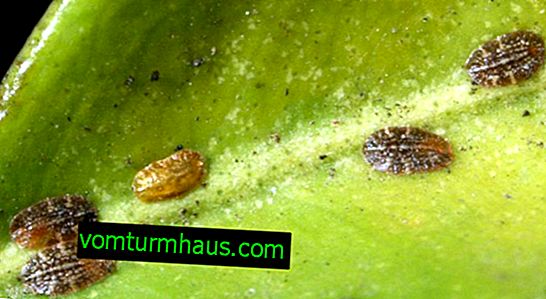
- Паутинным клещом (узнать его несложно по тонким, практически прозрачным нитям, густо оплетающим черешки, а также по коричневым точкам с изнаночной стороны листовой пластины).
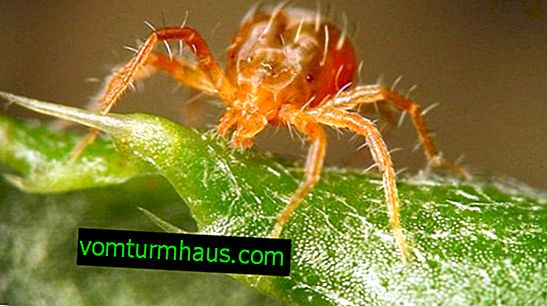
- Трипсами (обесцвечивают растение и оставляют небольшие чёрные точки с изнаночной стороны растения, иногда дополненные тонкими серебристыми царапинами).
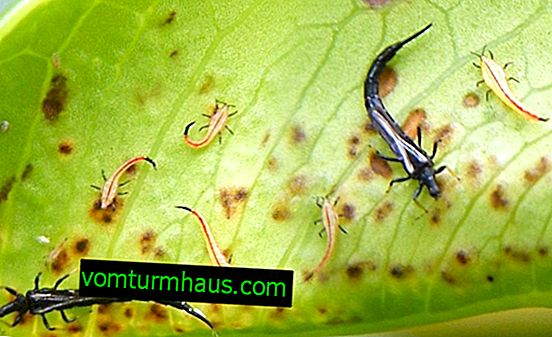
- Тлёй (если посмотреть на драцену под увеличительным стеклом, то можно заметить значительные колонии мелких насекомых, густо облепляющих изнаночную сторону листьев и верхнюю часть ствола).
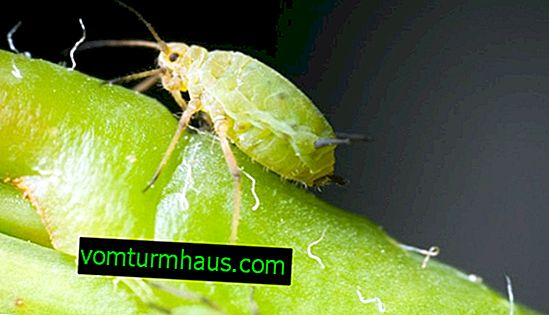
- Мучнистым червецом (оставляет небольшие сгустки серого налёта в пазухах листовых пластин, из-за которых они быстро желтеют и засыхают).
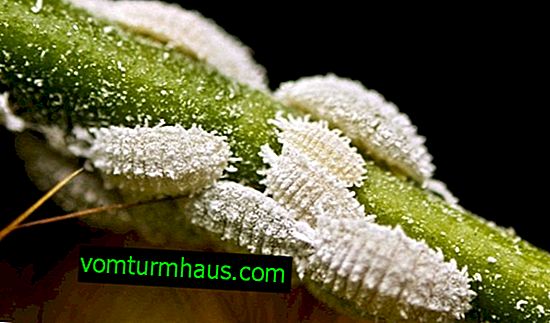
Did you know? По лечебным свойствам сок драцены приравнивается к соку известного алоэ; он обладает антиоксидантным воздействием и его можно использовать для укрепления сердечной мышцы и иммунной системы человека.
Useful Care Tips
При выращивании садовых или декоративных растений очень важен опыт профессиональных садоводов, поэтому предлагаем вам несколько общих рекомендаций, которые помогут в уходе и сохранении декоративных свойств драцены:
- Чтобы кончики листьев деревца не засыхали, всегда контролируйте уровень влажности в помещении и отсутствие сквозняков.
- Мягкие и скрученные листья могут свидетельствовать о переохлаждении растения, причём нередко для появления этих симптомов достаточно всего одной ночи, проведённой в холодном помещении.
- Даже если вы выращиваете солнцелюбивые разновидности драцены, лучше защитить их от прямых солнечных лучей, которые могут привести к появлению сухих светлых пятен на листьях.
- При укоренении черенков в воде всегда добавляйте туда таблетку активированного угля, который защитит корневую систему от загнивания.
- Нижние листовые пластины деревца в нормальных условиях хорошо выглядят в течение 2-3 лет, поэтому если они начали желтеть раньше — стоит пересмотреть режим освещения и уровень влажности в комнате.
- Чересчур яркая окраска листьев иногда свидетельствует об избытке азотных удобрений или нехватке света, поэтому прежде, чем искать причину в других особенностях, стоит рассмотреть такую вероятность.
- Хорошему ветвлению драцены способствует высокая влажность и достаточное количество света, но в некоторых случаях этого недостаточно. Обязательно учитывайте разновидность растения, ведь, к примеру, драцена Сандера всегда характеризуется ограниченным ветвлением.









